
Open Fire: Solitaire Tank Combat in WWII is a solitaire board wargame published by Victory Games in 1988.

Open Fire: Solitaire Tank Combat in WWII is a solitaire board wargame published by Victory Games in 1988.
Victory Games published Ambush! , a man-to-man combat wargame, in 1983 that used an innovative system of paragraphs and pre-programmed enemy responses to allow for solitaire play. Open Fire, a game of tank warfare set in World War II, uses the same game system. [1] The player controls the Allied forces, while the game mechanics control the German forces.
The player picks one of six scenarios and places specified event markers on the map. The player either generates a tank platoon with random die rolls or uses a pregenerated platoon, and then spends a specified number of quality points to upgrade men and tanks. [1]
When the player moves a tank to a point on the map that has clear line of sight to an event marker, then the player uses the mission cartridge in the cartridge reader to see if there is a paragraph number. If there is, the player reads the relevant paragraph, which activates one or more German units. Once combat is finished, the player continues to the next event marker. [1]
Each scenario outlines how the player accumulates victory points, and how many points are required to declare victory. [1]
In 1982, Simulations Publications, Inc. (SPI) ran into financial difficulties and was taken over by TSR. In the aftermath, many SPI staff members left or were let go. Rival game company Avalon Hill hired some of them, and formed them into a subsidiary, Victory Games. One of their releases, Open Fire, was designed by ex-SPI designer Gerard Christopher Klug, with cover art by James Talbot, and was published in 1988. [2]
In the inaugural issue of Games International , Brian Walker (with help from Derek Wilson and Ian Brown) had an overall favorable impression of the game, although he found the quality of the scenarios varied from mission to mission. He also questioned the relatively high price of the game versus its replayability once the player has finished the six scenarios. Walker found several errors and omissions in the rules, and pointed out that although most of the errors were minor, "for the price you would expect the rules to be a bit more polished and the missions to be a bit better thought out." He concluded by giving the game an average rating of 3 stars out of 5, saying, "The game should have some appeal to role-players because of the identification with characters, and if Victory could throw in a few tank-driving Orcs in the expansion modules then the sales potential of the game could know no bounds." [1]
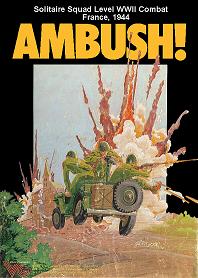
Ambush! is a man-to-man wargame developed by Avalon Hill. It was released under Avalon's Victory Games label and was developed by Eric Lee Smith and John Butterfield. It has been out of print since Avalon Hill was disbanded in 1998.

The Campaign for North Africa (CNA), subtitled "The Desert War, 1940–43", is a strategic board wargame published by Simulations Publications, Inc. (SPI) in 1978 that simulates the entire North African campaign of World War II. It is considered one of the most complex wargames ever published, with ten recommended players and an estimated total playtime of 1,500 hours. The game could not be fully playtested before release and it is not known if a game has ever been completed.
Sniper!, subtitled "House-to-House Fighting in World War II", is a two-player board wargame about man-to-man combat in urban environments during WWII, originally released in 1973 by Simulations Publications Inc. (SPI). After TSR purchased SPI in 1982, TSR released an expanded edition of Sniper! in 1986, and followed up that up with releases of various "companion games" and a videogame.
Board wargaming in the modern, commercial sense have generally concentrated on gameplay designed for two or more participants. While playing solitaire is possible with any game, it is generally done so as an exercise in analysis rather than for enjoyment.

Grunt, subtitled "The Game of Tactical Level Combat in Vietnam", is a tactical level board wargame published by Simulations Publications, Inc. (SPI) in 1971, set in the Vietnam War. It was the first board wargame to focus on squad level combat, and the second to simulate parts of the Vietnam War, which was still ongoing at the time this game was published.

Ranger: Simulation of Modern Patrolling Operations is a tactical solitaire board wargame released by Omega Games in 1984. It was billed as a "game of modern patrolling". The game was designed by Bill Gibbs, and focussed on contemporary small unit actions, placing the player in the position of a patrol leader.

Tactical wargames are a type of wargame that models military conflict at a tactical level, i.e. units range from individual vehicles and squads to platoons or companies. These units are rated based on types and ranges of individual weaponry. The first tactical wargames were played as miniatures, extended to board games, and they are now also enjoyed as video games.

Invasion: America, subtitled "Death Throes of the Superpower", is a near-future board wargame published by SPI in 1976 that simulates a hypothetical coordinated attack on North America by various factions.

Conquistador, originally subtitled "The Age of Exploration: 1495–1600", is a board game published by Simulations Publications, Inc. (SPI) in 1976 that simulates the exploration of the New World in the 16th century. Players take on the role of European countries sending expeditions to find gold and establish colonies. Although the design uses the trappings of board wargames such as a hex map, combat is not a major part of the game.

Tobruk, subtitled "Tank Battles in North Africa 1942", is a board wargame published by Avalon Hill in 1975 that simulates tank combat in North Africa during World War II.
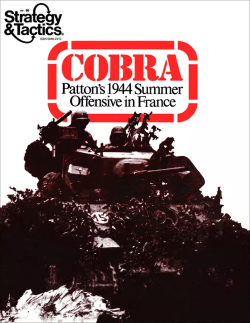
Cobra: Game of the Normandy Breakout, originally titled Cobra: Patton's 1944 Summer offensive in France, is a board wargame published by Simulations Publications Inc. (SPI) in 1977 that simulates the 1944 breakout of Allied forces from Normandy following D-Day.
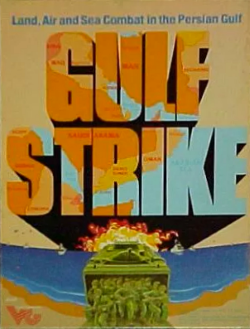
Gulf Strike, subtitled "Land, Air and Sea Combat in the Persian Gulf", is a board wargame published by Victory Games in 1983. The first and second editions were hypothetical games focussed on American responses to Iranian aggression in the Persian Gulf. The third edition, published in 1990, was updated to reflect the reality of Operation Desert Shield during the Gulf War.

Dieppe, subtitled "An Operational Game of the Allied Raid on Fortress Europe, August 1942", is a board wargame published by Simulations Canada in 1977 that is a simulation of Operation Jubilee, the disastrous Dieppe Raid made by Canadian and British forces during World War II.

The Battle of Borodino: Napoleon in Russia 1812 is a board wargame published by Simulations Publications Inc. (SPI) in 1972 that is a simulation of the Battle of Borodino during the French invasion of Russia in 1812.
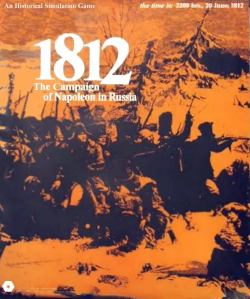
1812: The Campaign of Napoleon in Russia is a collection of two board wargames published by Simulations Publications Inc. (SPI) in 1972 that both simulate Napoleon's disastrous invasion of Russia. One game uses a traditional hex grid map, and the other uses a map of areas and regions.

Kursk: Operation Zitadelle is a board wargame published by Simulations Publications Inc. (SPI) in 1971. It was the first wargame to simulate the Battle of Kursk, the large tank battle during World War II.

MechWar '77, subtitled "Tactical Armored Combat in the 1970s", is a board wargame published by Simulations Publications Inc. (SPI) in 1975 that simulates hypothetical tank combat in the mid-1970s between various adversaries, using the same rules system as the previously published Panzer '44.

Atlantic Wall, subtitled "The Invasion of Europe June 1944", is a board wargame published by Simulations Publications Inc. (SPI) in 1978 that simulates Operation Overlord during World War II, when Allied forces landed on Normandy beaches and attempted to break out into open country.

Desert War: Tactical Warfare in North Africa is a board wargame published in 1973 by Simulations Publications, Inc. (SPI) that simulates combat in North Africa during World War II..
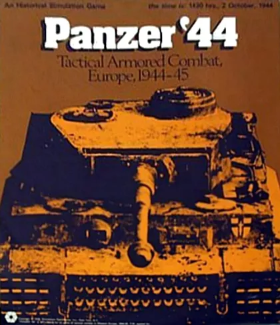
Panzer '44: Tactical Combat in Western Europe, 1944–45 is a board wargame published by Simulations Publications Inc. (SPI) in 1975 that simulates historical tank combat during World War II.